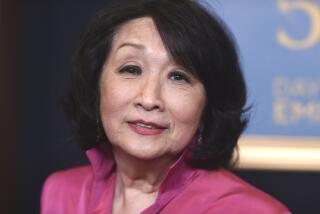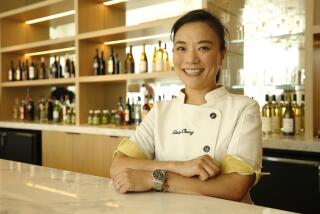Chinese American Was ‘Mom’ to 1,000 Servicemen
- Share via
Adversity and long odds meant nothing to Margaret Chung.
In 1916, she surmounted both tradition and bigotry to become the nation’s first American-born female physician of Chinese ancestry, practicing in Los Angeles and later San Francisco.
Compared with such obstacles, the war against fascism and militarism was just one more challenge that Chung threw herself into. In the process, she inspired a movie and a comic book, and became as integral a part of the World War II effort as Glenn Miller and Victory Bonds.
In the war’s service, she recruited pilots for the Flying Tigers, pressured the government to create the Navy WAVES for women, and accumulated more than a thousand pilots who considered themselves her “sons.” In her quarter-century of fame, movie stars were among her patients and an admiral was among her pallbearers.
But before she became a symbol and a surrogate mother to the nation’s fighting men, she was a symbol of social progress and medical professionalism.
Born in Santa Barbara in 1889, the daughter of immigrants, Chung was the eldest of 11 children. Growing up on the 24,000-acre Rancho Guadalasca in Ventura County, where her father was the foreman, Chung decided at an early age that she wanted to be a doctor.
She was propelled not only by her stubbornness and appetite for learning, but by a strict Presbyterian upbringing and a charismatic family doctor who made ranch house calls on his bicycle.
By 1902, her family had moved to Los Angeles, where her father worked as a vegetable peddler. Determined to study medicine at USC, she knocked on the doors of hundreds of Angelenos, selling newspaper subscriptions that won her a Los Angeles Times scholarship.
That scholarship opened academic doors for her, but she still had to work in the school cafeteria, sell surgical instruments and win cash prizes in several speech contests to make ends meet.
On top of that, two years before Chung graduated from medical school in 1916, her mother died of tuberculosis. The young woman also had to care for her siblings.
For the class picture on graduation day, she put on a mannish shirt and tie and slicked back her hair, making it hard to tell that she was the only woman in the class.
But she was denied an internship at every hospital where she applied. It was a step down, but she agreed to work as a surgical nurse at the Santa Fe Railroad Hospital in Boyle Heights.
Months later, she was finally accepted at the Mary Thompson Women’s and Children’s Hospital in Chicago. After that she became a staff resident at the State Hospital for the Criminally Insane in Illinois.
But after less than two years in Chicago, she was summoned back to Los Angeles; her father had bled to death after he was hit by a streetcar. She returned to the Santa Fe Railroad Hospital, this time as a staff surgeon. She also began to build a thriving medical practice that enabled her to care for patients who couldn’t pay.
By the early 1920s, she had abandoned her Presbyterian faith and moved to San Francisco’s Chinatown, all the while maintaining her small practice in Los Angeles. Getting a foothold in San Francisco wasn’t easy. Not only was she the first female doctor to practice there, but she used Western medicine while most of Chinatown still patronized traditional Chinese herbalists.
Her practice extended beyond Chinatown, though. At the beginning of the Depression, she was asked to conduct medical exams for seven hard-drinking crack Navy reserve pilots. More than that, Chung, who had a reputation for treating patients to home-cooked meals, fed the seven, who were soon referring to themselves as “Mom Chung’s Fair-Haired Bastard Sons.” They were the core of what became nearly a thousand loyal wartime “flyboys” who called her “Mom.”
But her care extended to the rich and famous as well. As a physician to the stars, she cut away Mary Pickford’s swollen tonsils and listened to tales of aches and pains from Sophie Tucker, Helen Hayes and Tallulah Bankhead.
As a patron of the arts, she never missed opening nights, always wearing an elegant evening gown and ermine jacket. After a performance, she often dined with Los Angeles Philharmonic conductor Leopold Stokowski or invited the whole company, musicians or actors, back to her house for a late supper. Other stars, among them Ronald Reagan and Robert Young, became known as the “Kiwis” because, unlike her pilot proteges, the stars were flightless.
In the years before World War II, she began to bestow on her pilot “sons” a jade Buddha, which each wore on a gold chain around his neck. Throughout the war, fliers in saloons around the world recognized one another by that Buddha. The submarine commanders and other naval officers whom she called her Golden Dolphins--among them actor Henry Fonda--were given special leather notebooks.
By 1937, when the Japanese invaded China, Chung was eager to be where the action was and volunteered as a front-line surgeon. But both Chinese and American authorities agreed that she was of more value stateside. Undeterred, she pressed for another kind of mission, and got one: a secret assignment.
Unofficially, with financial backing from the Chinese government, she began recruiting hundreds of American pilots to help defend China against Japan. These “sons” wore no uniforms and carried no ranks as they signed up with the newly formed American Volunteer Group, headed by “son” Brig. Gen. Claire L. Chennault.
Members of the group were soon known as the Flying Tigers because the noses of their P-40 Tomahawk fighter planes were painted with rows of gleaming teeth. These markings became their trademark. The fliers were paid bonuses for each aerial victory.
During the war years, Chung wore a Red Cross uniform and continued to mother her “sons” when they came to San Francisco. The walls of her red and gold office were covered with their cables, photos and souvenirs.
The trophy gifts they sent her included bits of aircraft from famous disasters, such as a fragment of the plane that crashed in Alaska, killing humorist Will Rogers and Wiley Post, and a fragment from the 1937 explosion of the Hindenburg airship.
As her fame grew, she became the inspiration for the 1939 movie “King of Chinatown,” a fictionalized bio-pic starring Chinese- American actress Anna May Wong. During the war, Chung shared the pages of Real Heroes comic books with the likes of President Franklin D. Roosevelt and the Texas Rangers, providing Chinese Americans with a patriotic role model.
By war’s end, Chung had lost some of her “sons” in combat. She made home-cooked meals for the returning heroes, and never forgot the name of a “son.” Routinely, when she entertained at home, the highest-ranking officer washed dishes, according to Vincent Turner, whose father, Vernon Turner, was one of her Golden Dolphins.
In 1949, four years after Winfield Scott Cunningham, who had commanded American forces on Wake Island, was released from a Japanese prison, Chung mailed back to him a weather-beaten parcel.
It had been sent to her, marked “missing in action,” in 1942. Inside were a leather wallet and a memo pad, gifts from Chung, and a note that read: “I’m so proud of you and your gallant stand.”
In the decade after the war, she retired from medical practice, and her “sons” pitched in and bought her a house in Marin County, where--still unmarried but the “mother” of many--she died of cancer in 1959. World War II naval hero Adm. Chester W. Nimitz, a Golden Dolphin, was a pallbearer.
More to Read
Sign up for Essential California
The most important California stories and recommendations in your inbox every morning.
You may occasionally receive promotional content from the Los Angeles Times.













